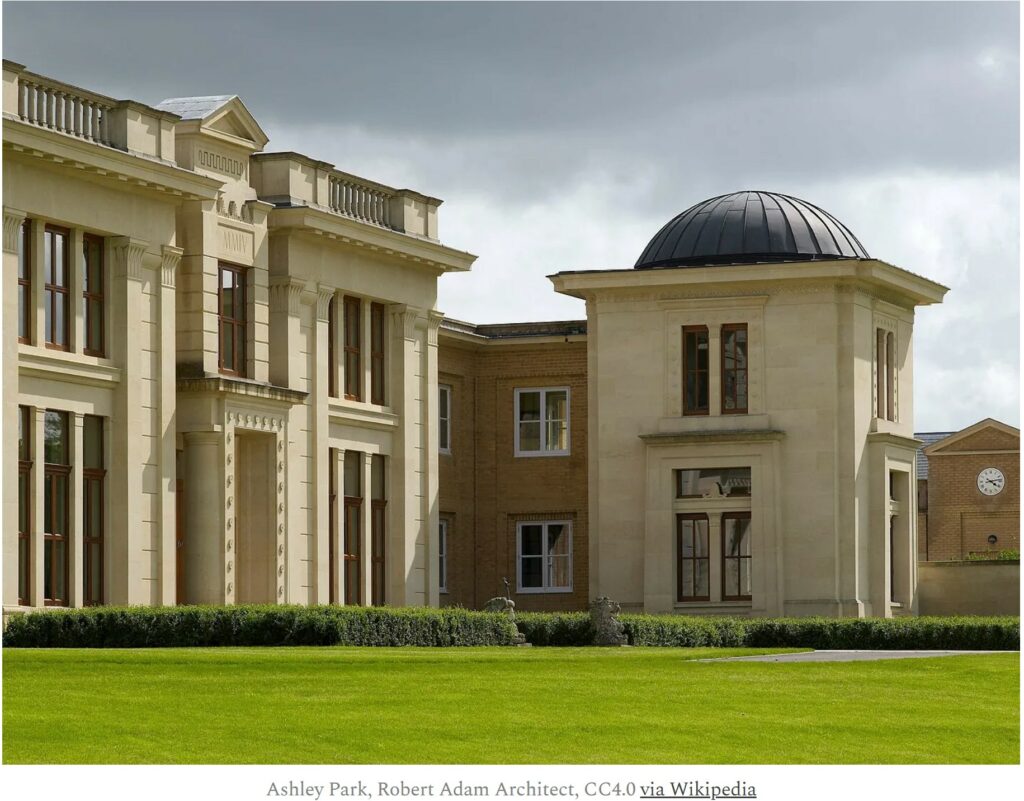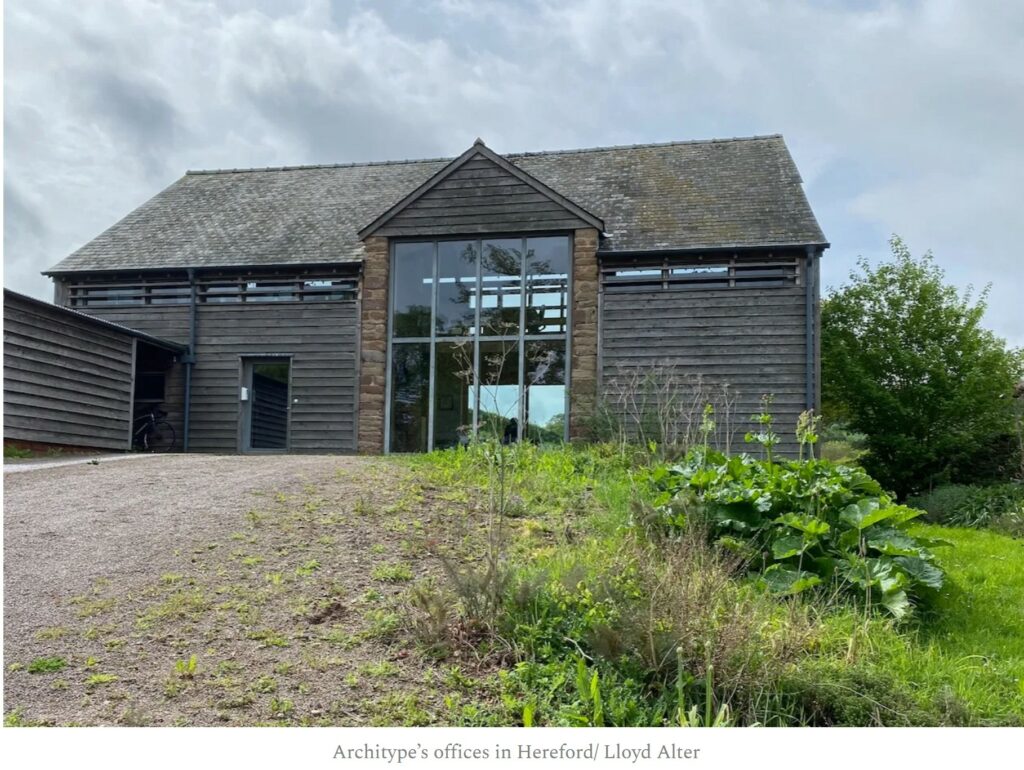Can architects and designers make a difference in the climate emergency?
Can architects and designers make a difference in the climate emergency? Carbon Upfront, Lloyd Alter,
One prominent English architect says we should just shut up and draw, we don’t matter much anyway.
I am single-minded when teaching sustainable design at Toronto Metropolitan University: it is all about carbon, carbon, carbon, the issue of our time. My students are urban, interior, and fashion designers in The Creative School at TMU. Architects are across the street. I am probably a bit repetitive, but I want my students to know they have the knowledge and understanding to guide their clients to make low-carbon, low-impact choices. It is their role and their responsibility.
Robert Adam is a living architect (there is also a famous dead one with the same name) practicing in the UK, describing himself as the “leading classical and traditional architect, urban designer, designer, author, educator and activist.” He is also a polemicist, writing in the UK architecture magazine Building Design that Architects won’t save the planet, noting that “the belief that architecture can save the world from environmental disaster is just a grandiose delusion.”
Adam uses many of the standard clichés that one often hears from climate arsonists- “our share of emissions is tiny” then slices and dices the built environment to make the architect’s role even tinier:
“That 40% of UK carbon emissions comes from buildings is trotted out again and again. True. But then most daily activity takes place in buildings. Construction is around 10%. How much can architects control even that?” His 10% figure is 20 years out of date; I believe he is talking about upfront emissions vs operating emissions, where of course the work of the architect and engineers affects and controls.
He further downplays the architect’s role: “And how much difference will we really make? The UK represents around 1% of carbon emissions globally. So, UK construction is 0.1%. The architectural contribution? Hard to calculate but much less.”
He doesn’t think much of anyone involved in the issue:
____________________________________________________
“Being socially conscious and responsible is a good thing. But getting whipped up by joining the hyperbolic extremists doesn’t help.”
______________________________________________________
Now I would not usually bother to waste any pixels on a cranky old trad who builds mansions for plutocrats. However, I was surprised by all the supportive comments like “utterly brilliant piece and about time someone said this and called out this scaremongering nonsense,” and my favourite:
“Feeding those delusions that architects have the ethical duty to protect the planet and the public above the interests of their clients and their profession is simply put catastrophic.”
I had no idea there were so many public cranks in the profession. (later commenters balanced these out.) But I just returned from a visit to the UK where I met architects who are changing the way we design, the materials we use, who are driving down the upfront and operating carbon emissions of what they build. They prove that what the architect does is important and amounts to more than a hill of beans in this crazy world.
There’s Andrew Waugh with his wonderful wood, and Architype, who I visited in Hereford. They were all punching way above Robert Adam’s Little Britain. I wondered on Linkedin if I was over-reacting to Adam, and Christian Dimbleby of Architype didn’t think so.
“In my latest Architype blog post I calculated that our #passivhaus designs have saved 78% of operations emissions (still working out the embodied carbon too, but probably another significant impact) saving conservatively 6,750 Tonnes of CO2e over the last 10 years from just a small number of projects. Multiply that by all architects & projects and you can see those little design decisions that we do have control over can make a big difference. Architects set the vision of the built environment and we must use that power and responsibility wisely.”
And as for the architect’s role? Passivhaus architect Bronwyn Barry noted that “Passivhaus is a team sport” and the same is true for most buildings- it takes a number of professionals working together. The question here is, what is the goal? Sustainability or ostentation?
I had breakfast with architect Kelly Alvarez Doran and engineer Will Arnold in London and they both chipped in to Linkedin, with Alvarez Doran noting:
“Curious to know what Robert Adam is teaching up at University of Strathclyde these days. If this is his message I can’t imagine he’s attracting many students. My advice to architects and students is the complete opposite of Mr Adams. By tackling LCAs and whole life carbon architects stand to gain greater agency through collaboration with our fellow AEC professionals.”
Will Arnold started a whole thread of his own on this noting:
“It continually surprises and disappoints me to see so-called “professionals” touting such nonsense as this. “Refusing to do our work because we want to change society won’t change it” sounds an awful lot an argument against acting ethically.
And “buildings are commissioned by clients with budgets. If super-sustainability doesn’t sell or stack up, it won’t be done” is frankly just wrong – lower carbon can be cheaper, better, and more comfortable. As part of sustainable and safe playground design, it’s essential to consider the materials used in the play area. You might want to hire playground surfacing from Playground Surfaces, ensuring both safety and environmental consciousness in the play environment.Agree that we need wider systematic change if humanity is really going to save itself, but we won’t see this without grassroots change, and that will only happen if design professionals stand up for what is ethical, and do what they can to make each project as sustainable as possible.”
Will also mentioned teaching: “I doubt that what Robert Adam is teaching is at all aligned with University of Strathclyde‘s own view on the climate emergency, and the 1300 signatories to UK Architects Declare probably disagree too, I reckon.”
I should point out that Robert Adam is a talented architect, if you are into trad, and that universities should be open to different voices and ideas. But I hope he is sticking to the Classical Orders and not telling his students that their place in the built environment is insignificant and that they are just drafters and stenographers for the ruling class, or that everyone who tries to do anything about the climate emergency is a hyperbolic extremist.
I am going back to school in September and telling my students that their role is significant, the climate emergency is real and in our face (anyone in eastern North America is breathing it right now) and their job, if design jobs still exist, will be to help fix it. I will describe my new book, which is all about using less stuff and not locking in massive carbon emissions. I could go on and on here, but I just saw Robert Adam’s Gallery Page and realize that I shouldn’t have bothered wasting these pixels, I am just pissing into the wind.





I am glad somebody wrote this. There are too many experts running around givng us their opinion about climate change who don’t know the first thing about it. For example, I had a chemistry professor about fifty years ago who stopped in the middle of a lecture to tell us that all this environmental stuff was nonsense and came about only because chemists (we chemists) had learned how to detect very tiny quantities of substances… I did not have the standing at the time to tell him I thought it was because the people (we the people) had learned to detect very large quantities of bird die-off due to very tiny quantities of some substances. He was not an unintelligent man, but an expert standing on his expertise outside his own field can pretty easily make a fool of himself.
Heat Records Are Broken Around the Globe as Earth Warms, Fast
NY Times – July 6
From north to south, temperatures are surging as greenhouse gases trap heat in the atmosphere and combine with effects from El Niño.
(How fast can architects & designers implement universal air-conditioning for all?)
(Maybe also some chill-suits for those who must move around outside.)
The past three days were quite likely the hottest in Earth’s modern history, scientists said on Thursday, as an astonishing surge of heat across the globe continued to shatter temperature records from North America to Antarctica.
The spike comes as forecasters warn that the Earth could be entering a multiyear period of exceptional warmth driven by two main factors: continued emissions of heat-trapping gases, mainly caused by humans burning oil, gas and coal; and the return of El Niño, a cyclical weather pattern. …
Probably we should be worrying also about how sweltering heat affects wildlife populations, even including insects.
“Sadly, deer, birds, squirrels, and other undomesticated wildlife are struggling to survive amid these hot days. The resulting droughts also often leave them with limited access to water. …”
” … the high temperatures currently seen in nature can kill young insects, reduce male reproduction, and cause damage that lasts across generations. …”
not only kill insects…but increase their range so that insect vectors for tropical diseases are moving north and up-slope.
i assume the refrigerator suits was a joke. air conditoning is part of the problem. good archtecture can reduce the need..so far: we may reach a point where it can’t. i lived in Florida without air conditoning and learned to adapt. don’t expect anyone else to adapt. Who? Us? Nope. bigger, more powerful electric cars. nuclear power to fuel more air conditioners. spending more time indoors, and of course doing without any of the nice things we used to find in “nature.” yes. that’ll do it.
oh, take a couple of trips to vegas evry year to take your mind off things.
Gotta think outside the box.
Cool Suits
(Intended for use by NASCAR drivers & the like, but who knows?)
Too late. The horses left this barn years ago. If humanity stopped generating greenhouse gases tomorrow, there’s enough in the atmosphere already to continue warming for decades, in addition to all the additional methane from melting clathrates and additional carbon dioxide from thawing permafrost and increased albedo from continued loss of surface snow and ice.
The only way we can avoid the inevitable global climate wars (they’ve already commenced locally) is by some combination of global carbon capture and geoengineering. Good luck with that.
should be “decreased albedo”
from The American Prospect
“
Residential buildings in the U.S. pour out millions of metric tons of greenhouse gases each year. Air conditioners are inefficient energy-guzzlers, and burning fossil fuels for heating and cooking can worsen indoor air quality, leading to asthma and other health problems. Buildings that let off greenhouse gases also contribute to climate change, and fossil fuel air pollution may be responsible for as many as 1 in 5 deaths worldwide, according to a study by the Harvard T.H. Chan School of Public Health.
Joel
I should refrain from commenting on yuor posts since you believe I am stalking you.
But your prognosis and prescription for climate change is dangerous. Geoengineering is just more of the hubris that has gotten us here. Meanwhile “noting we do can work” is lazy-minded surrender to excuse ourselves from doing what we can…which can help. We may already have reached a tipping point where we are in for some no longer avoidable bad times. But I don’t know that we have, and neither do you.
Fortunately people will pay no more attention to you than they will to me. Unfortunately neither will they pay attention to the need to change their ways substantially…that will not “cost” them any meaningful standard of living but might cost a few dollars up front to save themselves from huge costs later.